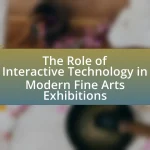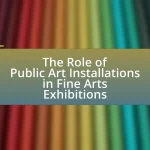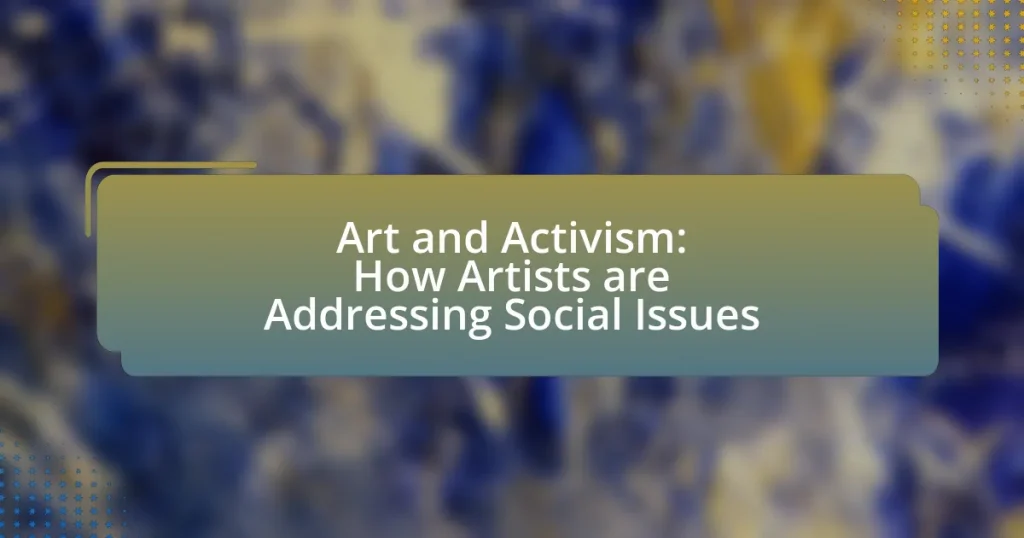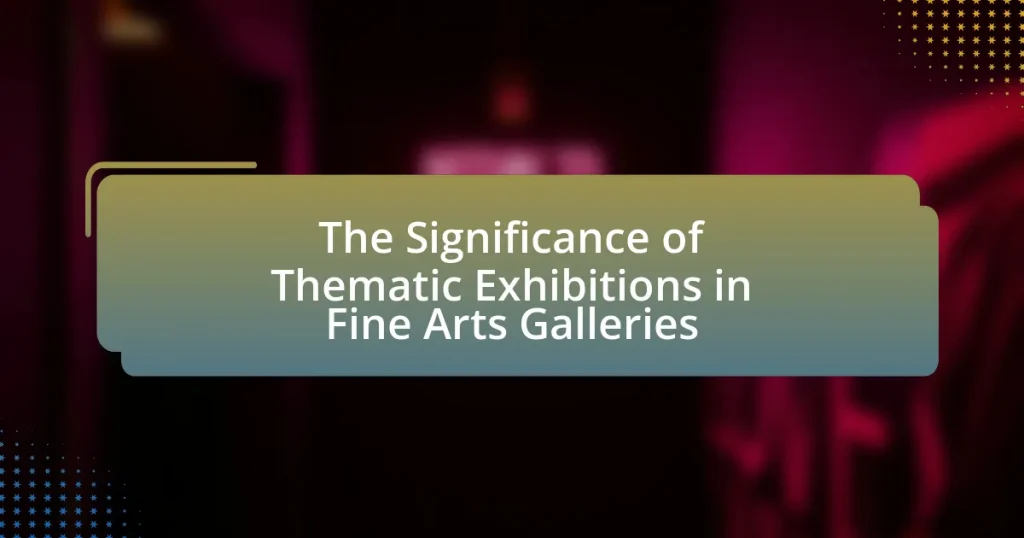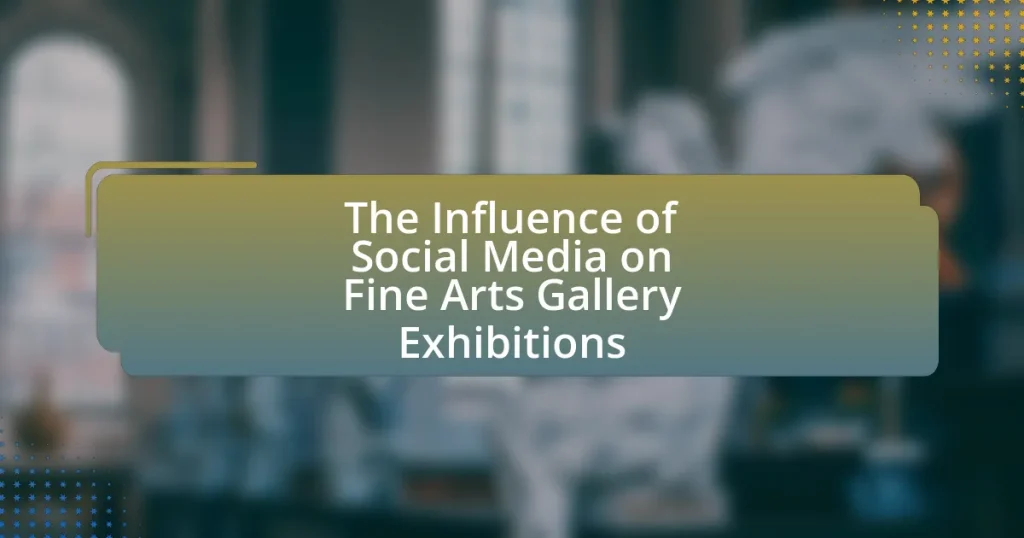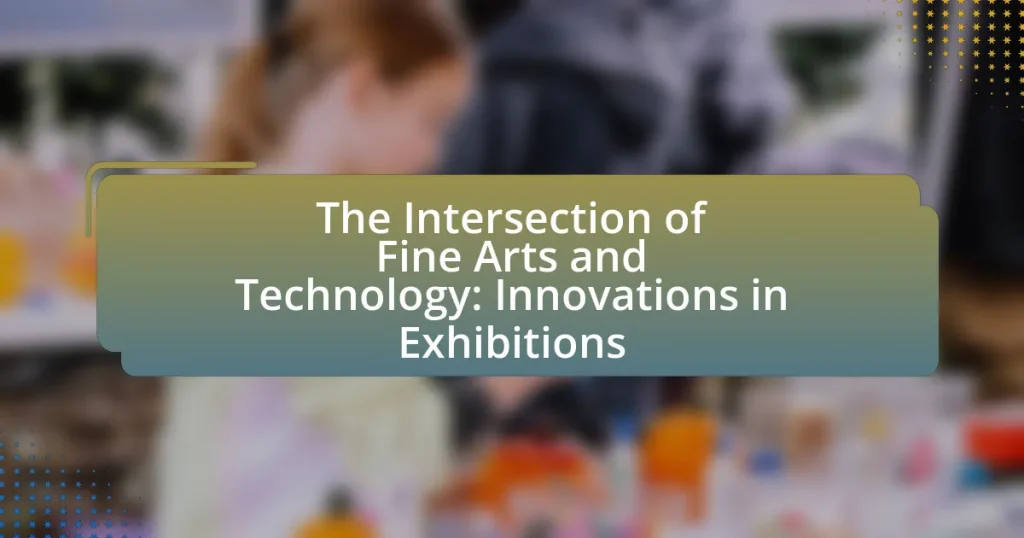Art and activism are interconnected as art serves as a vital medium for social change and political expression. The article explores how artists utilize various forms of art, including visual art, performance, and digital media, to address social issues such as human rights abuses, racial inequality, and environmental concerns. It highlights historical examples of art as activism, such as Diego Rivera’s murals and Picasso’s “Guernica,” while also examining contemporary movements like Black Lives Matter. Additionally, the article discusses the psychological impacts of art on audiences, the role of community engagement, and successful case studies that demonstrate the effectiveness of art in mobilizing public opinion and influencing policy.
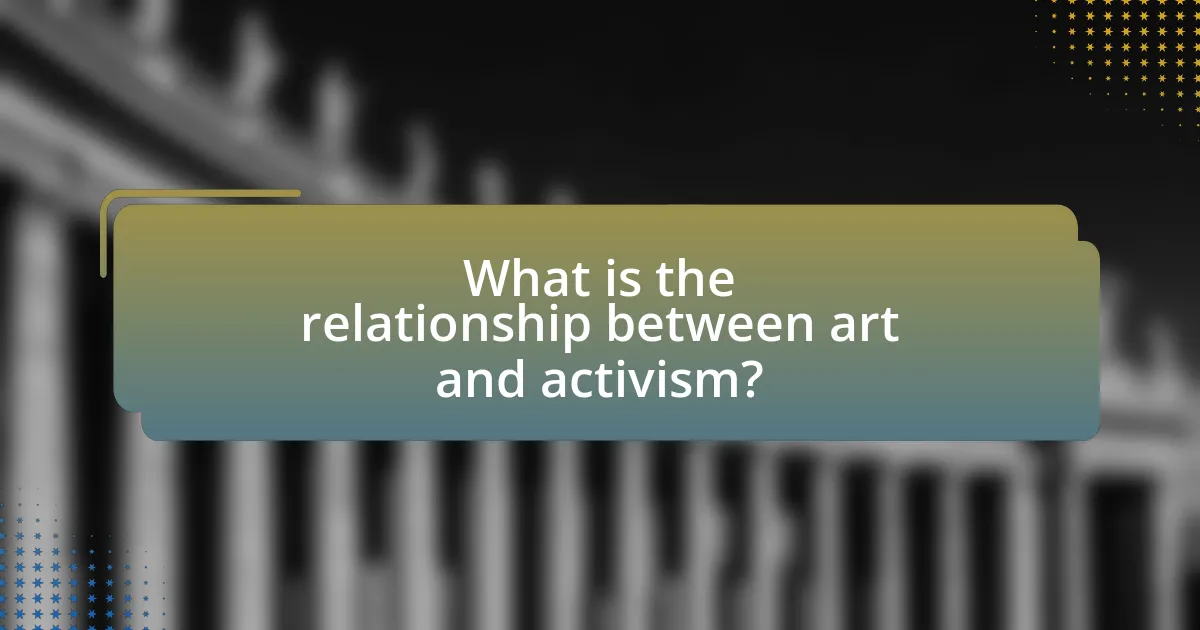
What is the relationship between art and activism?
Art and activism are intrinsically linked as art serves as a powerful medium for social change and political expression. Artists often use their work to raise awareness about social issues, challenge injustices, and inspire action among audiences. For instance, the works of artists like Ai Weiwei and Banksy have highlighted human rights abuses and social inequalities, effectively mobilizing public discourse and activism. Historical movements, such as the Civil Rights Movement in the United States, utilized art forms like music, visual arts, and literature to communicate messages of resistance and hope, demonstrating that art can be a catalyst for social transformation.
How do artists use their work to address social issues?
Artists use their work to address social issues by creating pieces that provoke thought, inspire dialogue, and raise awareness about societal challenges. For instance, artists like Ai Weiwei utilize installations and public art to comment on human rights abuses, while street artists like Banksy often highlight issues such as poverty and war through provocative murals. These artistic expressions serve as a platform for marginalized voices, encouraging audiences to engage with and reflect on critical social topics. The impact of such works can be seen in movements like Black Lives Matter, where visual art has played a significant role in mobilizing support and fostering community discussions around racial injustice.
What are some historical examples of art as activism?
Historical examples of art as activism include the works of Diego Rivera, whose murals depicted social injustices and the struggles of the working class in Mexico during the early 20th century. Another significant example is the “Guernica” painting by Pablo Picasso, created in response to the bombing of Guernica during the Spanish Civil War, symbolizing the horrors of war and the suffering it causes. Additionally, the AIDS Memorial Quilt, initiated in 1987, serves as a powerful visual representation of the impact of the AIDS crisis, honoring those who lost their lives and advocating for awareness and action. These examples illustrate how art has been utilized to raise awareness, provoke thought, and inspire social change throughout history.
How does contemporary art reflect current social movements?
Contemporary art reflects current social movements by serving as a platform for dialogue and activism, often addressing issues such as racial inequality, gender rights, and climate change. Artists utilize various mediums to express their perspectives, challenge societal norms, and provoke thought, thereby engaging audiences in critical conversations. For instance, the Black Lives Matter movement has inspired numerous artworks that highlight systemic racism and police brutality, with artists like Kehinde Wiley and Hank Willis Thomas creating pieces that confront these issues directly. Additionally, the rise of digital art and social media has amplified the reach of these messages, allowing for broader participation and awareness. This intersection of art and activism demonstrates how contemporary art not only mirrors societal concerns but also actively contributes to the discourse surrounding them.
Why is art an effective tool for social change?
Art is an effective tool for social change because it has the power to evoke emotions, provoke thought, and inspire action among diverse audiences. Through visual imagery, performance, and storytelling, art can communicate complex social issues in accessible ways, making it easier for individuals to engage with and understand these topics. For instance, the use of murals in urban areas has historically raised awareness about social injustices, as seen in the Civil Rights Movement, where artists like Charles White depicted the struggles of African Americans, fostering empathy and mobilizing communities. Additionally, studies have shown that art can influence public opinion; a report by the National Endowment for the Arts found that arts engagement can lead to increased civic participation and social cohesion. Thus, art not only reflects societal issues but also serves as a catalyst for dialogue and change.
What psychological impacts does art have on audiences?
Art significantly impacts audiences psychologically by evoking emotions, fostering empathy, and facilitating self-reflection. Research indicates that engaging with art can lead to increased emotional awareness and understanding, as it often mirrors personal and societal experiences. For instance, a study published in the journal “Psychological Science” by Tamara L. Brown and colleagues found that individuals who viewed emotionally charged artwork reported heightened feelings of empathy and connection to others. Additionally, art can serve as a catalyst for social change by prompting audiences to reflect on social issues, thereby influencing attitudes and behaviors. This transformative power of art underscores its role in shaping psychological responses and promoting social awareness.
How does art foster community engagement and dialogue?
Art fosters community engagement and dialogue by serving as a medium for expression and connection among individuals. Through public installations, performances, and collaborative projects, art encourages participation and interaction, allowing community members to share their perspectives and experiences. For instance, community murals often reflect local histories and social issues, inviting residents to contribute to the artwork and engage in discussions about their shared environment. Research by the National Endowment for the Arts indicates that arts participation can enhance social cohesion and foster a sense of belonging, demonstrating that art not only reflects community values but also actively shapes them.
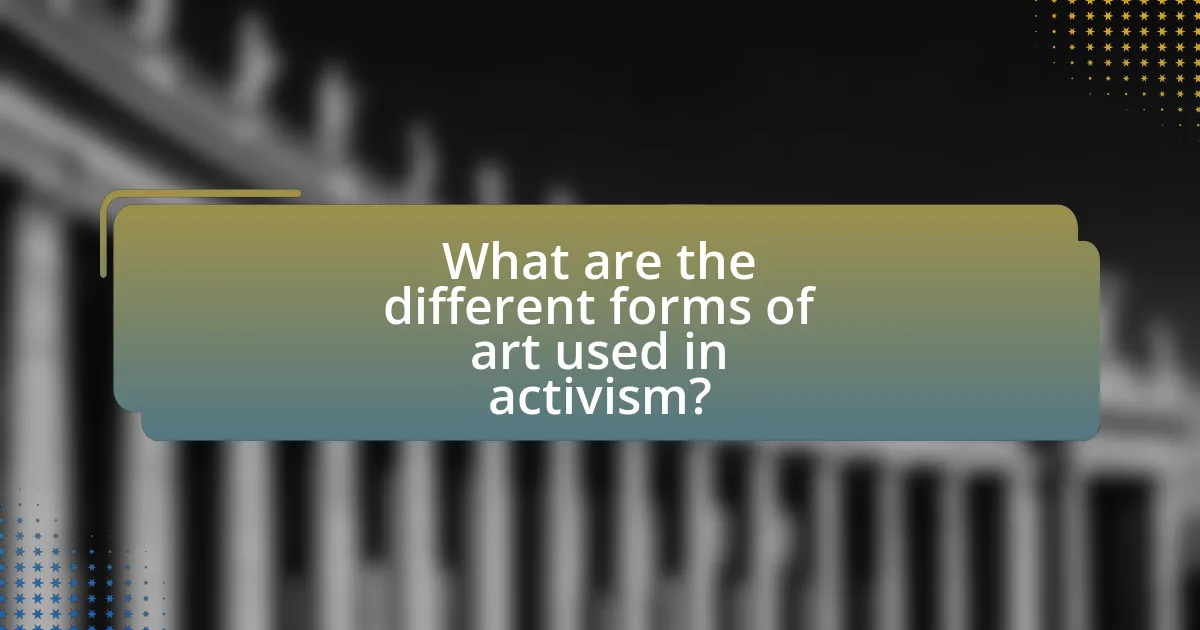
What are the different forms of art used in activism?
Different forms of art used in activism include visual art, performance art, music, literature, and digital media. Visual art, such as murals and graffiti, often conveys powerful messages about social issues, exemplified by the street art movement that emerged in response to political unrest. Performance art engages audiences in real-time, as seen in works by artists like Marina Abramović, who address themes of identity and social justice. Music serves as a rallying cry for movements, with protest songs historically uniting people around causes, such as Bob Dylan’s “The Times They Are a-Changin’.” Literature, including poetry and essays, articulates the struggles and aspirations of marginalized communities, as demonstrated by authors like Audre Lorde. Digital media, including social media campaigns and online art projects, amplifies activist messages to a global audience, leveraging platforms for widespread engagement. Each of these forms effectively communicates and mobilizes support for various social issues, demonstrating the integral role of art in activism.
How do visual arts contribute to social movements?
Visual arts contribute to social movements by serving as powerful tools for communication, expression, and mobilization. They visually articulate social issues, evoke emotional responses, and raise awareness, thereby fostering community engagement and solidarity. For instance, the use of murals in the Chicano civil rights movement in the 1970s effectively conveyed messages of cultural pride and social justice, galvanizing public support and activism. Additionally, contemporary art installations, such as those by Ai Weiwei, highlight human rights abuses and provoke global discourse, demonstrating how visual arts can influence public opinion and policy.
What role do murals and street art play in activism?
Murals and street art serve as powerful tools for activism by visually communicating social and political messages to a broad audience. These art forms often address issues such as inequality, racism, and environmental concerns, making complex topics accessible and engaging. For instance, the mural “The Great Wall of Los Angeles,” created by Judy Baca, highlights the history of marginalized communities and has become a significant landmark in social justice movements. Additionally, studies show that public art can foster community dialogue and inspire action, as seen in the rise of street art during protests like the Black Lives Matter movement, where artists used their work to amplify voices and demands for change.
How is performance art utilized to convey social messages?
Performance art is utilized to convey social messages by engaging audiences in immersive experiences that provoke thought and inspire dialogue about societal issues. Artists often use their bodies, space, and time to challenge norms, highlight injustices, and reflect cultural narratives. For instance, the work of artists like Marina Abramović, who explores themes of endurance and vulnerability, invites viewers to confront their own perceptions of pain and empathy, thereby addressing issues such as violence and trauma. Additionally, performance art can serve as a platform for marginalized voices, as seen in the works of artists like Tania Bruguera, who focuses on political activism and human rights, effectively raising awareness and fostering community engagement around critical social topics.
What is the significance of digital art in activism?
Digital art plays a crucial role in activism by providing a platform for marginalized voices and facilitating widespread engagement with social issues. This medium allows artists to create impactful visual narratives that can be easily shared across social media, reaching diverse audiences quickly. For instance, during the Black Lives Matter movement, digital art became a vital tool for raising awareness and mobilizing support, with artists using platforms like Instagram to disseminate powerful imagery that highlighted systemic racism and police brutality. The accessibility of digital art enables activists to bypass traditional gatekeepers, fostering a more inclusive dialogue around social justice.
How do social media platforms amplify activist art?
Social media platforms amplify activist art by providing a global reach and facilitating rapid dissemination of messages. These platforms enable artists to share their work widely, engage with diverse audiences, and mobilize support for social causes. For instance, the hashtag #BlackLivesMatter has been instrumental in spreading awareness and fostering community around racial justice, showcasing how social media can elevate activist art to a broader audience. Additionally, platforms like Instagram and Twitter allow for real-time interaction, enabling artists to connect with followers and other activists, thereby enhancing the impact of their messages.
What challenges do digital artists face in activism?
Digital artists face several challenges in activism, including censorship, the digital divide, and the commercialization of art. Censorship can limit the expression of political or social messages, as platforms may remove content deemed controversial or inappropriate. The digital divide creates barriers for artists who lack access to technology or the internet, hindering their ability to participate in online activism. Additionally, the commercialization of art can dilute the activist message, as artists may feel pressured to create work that appeals to commercial interests rather than social causes. These challenges can significantly impact the effectiveness and reach of digital activism efforts.
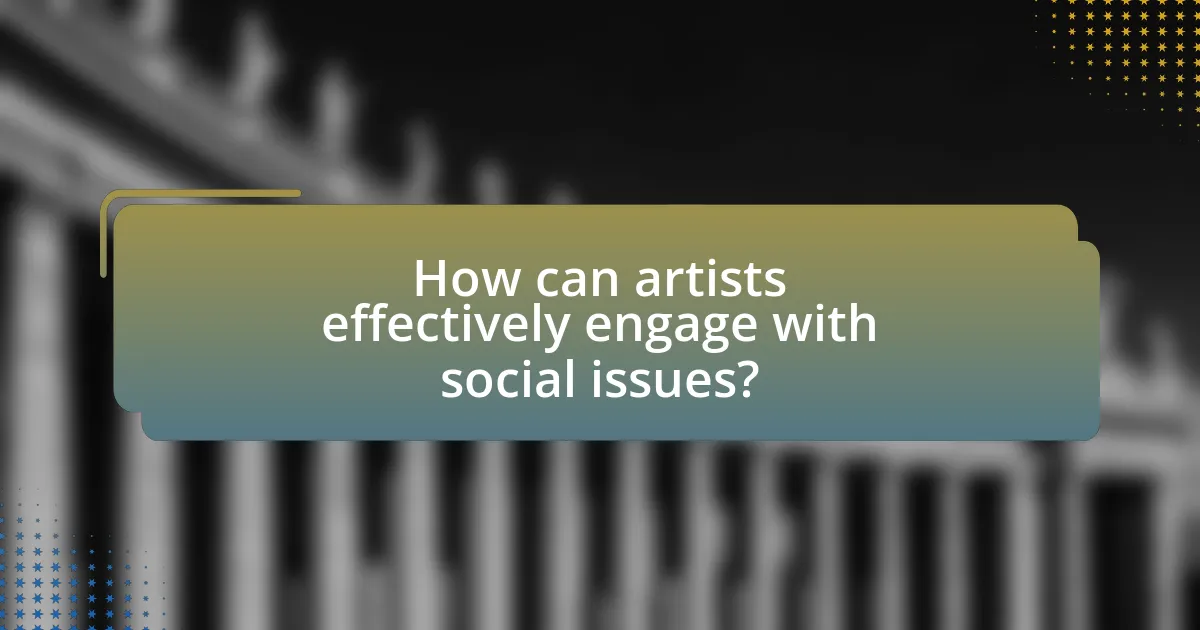
How can artists effectively engage with social issues?
Artists can effectively engage with social issues by using their work to raise awareness, provoke thought, and inspire action. Through various mediums such as visual art, music, and performance, artists can communicate complex social messages that resonate with audiences. For instance, the use of street art has been shown to transform public spaces into platforms for social commentary, as seen in the works of artists like Banksy, who addresses themes like war and consumerism. Additionally, collaborative projects that involve community participation can amplify voices that are often marginalized, fostering a sense of collective responsibility and empowerment. Research indicates that art can stimulate dialogue and mobilize communities, making it a powerful tool for social change.
What strategies can artists employ to raise awareness?
Artists can employ various strategies to raise awareness, including creating impactful visual art, engaging in social media campaigns, and collaborating with activist organizations. Visual art, such as murals or installations, can convey powerful messages that resonate with the public, as seen in the works of artists like Banksy, who addresses social issues through provocative imagery. Social media campaigns allow artists to reach a broader audience quickly; for instance, the #MeToo movement gained significant traction through artists sharing their experiences and artwork online. Collaborating with activist organizations enables artists to amplify their messages and connect with communities directly affected by social issues, exemplified by the partnership between artists and groups like Black Lives Matter to promote racial justice. These strategies effectively mobilize public attention and foster dialogue around critical social issues.
How can collaboration enhance the impact of activist art?
Collaboration can enhance the impact of activist art by combining diverse perspectives and skills, which amplifies the message and reach of the artwork. When artists collaborate with community members, activists, and other creatives, they create a richer narrative that resonates more deeply with audiences. For instance, the “Art for Social Change” initiative demonstrates how collaborative projects can engage various stakeholders, leading to increased visibility and support for social issues. This collective approach not only fosters a sense of community but also encourages dialogue, making the art more effective in driving social change.
What role does audience participation play in activist projects?
Audience participation is crucial in activist projects as it fosters engagement, amplifies voices, and enhances the impact of the message. By involving the audience, activist projects can create a sense of community and shared purpose, which is essential for mobilizing collective action. For instance, participatory art installations often invite viewers to contribute their thoughts or experiences, transforming passive observers into active participants. This interaction not only raises awareness but also empowers individuals, making them feel integral to the cause. Research shows that projects with high levels of audience involvement tend to achieve greater visibility and effectiveness in promoting social change, as seen in initiatives like the “People’s Climate March,” where participant numbers directly correlated with media coverage and public discourse.
What are some successful case studies of art and activism?
Successful case studies of art and activism include the AIDS Memorial Quilt, which has raised awareness about HIV/AIDS since its inception in 1987, and the “I AM a Man” campaign, which utilized photography to highlight civil rights issues during the 1968 sanitation workers’ strike in Memphis. The AIDS Memorial Quilt, created by artist Cleve Jones, consists of over 48,000 panels commemorating individuals lost to the disease, effectively humanizing the epidemic and fostering community support. The “I AM a Man” campaign, led by photographer Ernest Withers, captured the struggles of African American workers, influencing public perception and policy regarding labor rights. Both examples demonstrate how art can mobilize communities and effect social change.
How did specific artworks influence public opinion or policy?
Specific artworks have significantly influenced public opinion and policy by raising awareness and prompting social change. For example, Pablo Picasso’s “Guernica” powerfully depicted the horrors of war and the suffering of civilians during the Spanish Civil War, leading to increased anti-war sentiment and influencing political discourse around conflict. Similarly, the AIDS Memorial Quilt, which emerged in the 1980s, not only memorialized those lost to AIDS but also galvanized public awareness and policy changes regarding healthcare and funding for AIDS research. These artworks served as catalysts for dialogue, mobilizing communities and impacting legislative actions related to their respective issues.
What lessons can be learned from these case studies?
The lessons learned from these case studies highlight the significant impact of art as a tool for social change. Artists effectively use their work to raise awareness about pressing social issues, mobilize communities, and inspire action. For instance, the case studies demonstrate that visual art can provoke dialogue and challenge societal norms, as seen in campaigns addressing climate change and racial injustice. Furthermore, these examples illustrate the importance of collaboration between artists and activists, which enhances the reach and effectiveness of their messages. The success of these initiatives is supported by evidence showing increased public engagement and policy changes resulting from artistic interventions.
What practical steps can artists take to address social issues through their work?
Artists can address social issues through their work by creating impactful art that raises awareness, engages communities, and inspires action. They can utilize various mediums such as visual art, music, theater, and literature to convey messages about social justice, inequality, and human rights. For instance, artists can collaborate with local organizations to develop projects that reflect community concerns, thereby fostering dialogue and understanding.
Additionally, artists can participate in public exhibitions or performances that highlight specific social issues, drawing attention to them in a way that resonates with audiences. Historical examples include the AIDS Memorial Quilt, which not only commemorated lives lost but also educated the public about the AIDS crisis. By leveraging social media platforms, artists can amplify their messages and reach a broader audience, encouraging collective action and support for social change.
Through these practical steps, artists can effectively contribute to social discourse and mobilize communities towards addressing pressing social issues.



